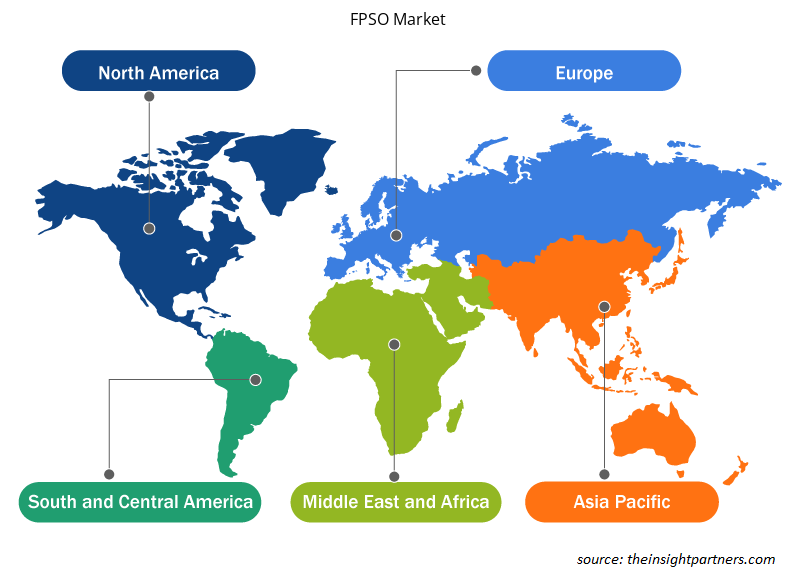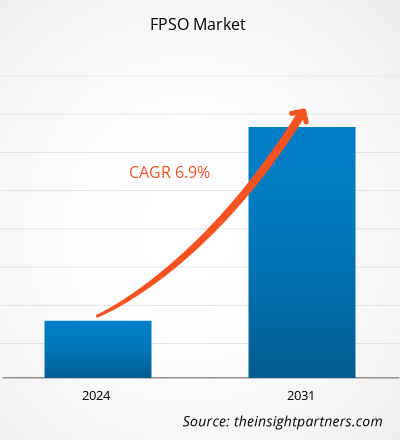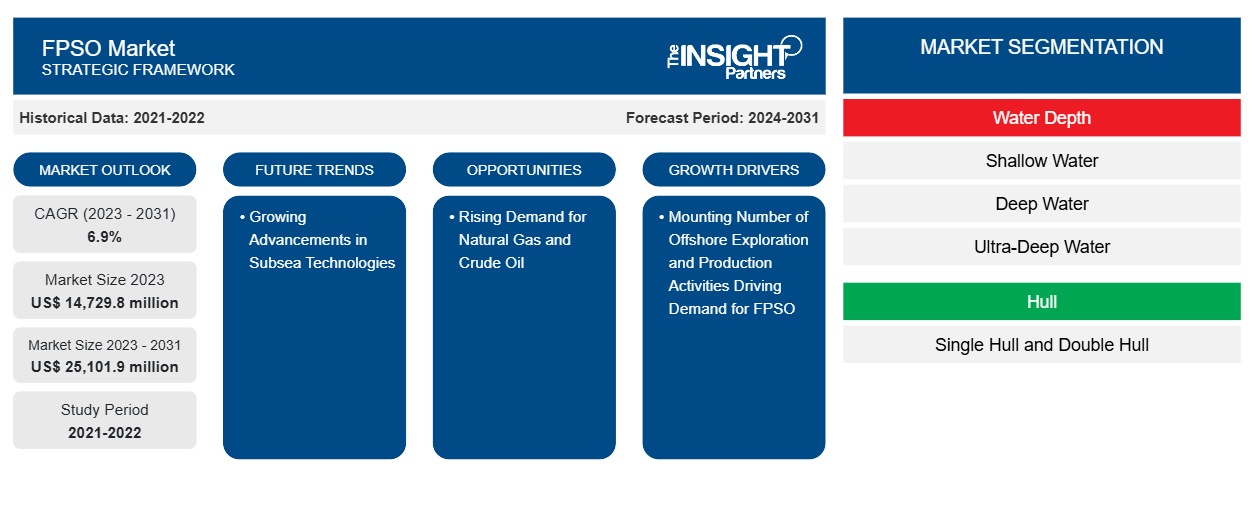La taille du marché des FPSO devrait atteindre 25 101,9 millions USD d'ici 2031, contre 14 729,8 millions USD en 2023. Le marché devrait enregistrer un TCAC de 6,9 % en 2023-2031. Le développement croissant du secteur pétrolier et gazier et l'augmentation des activités d'exploration pétrolière et gazière sont d'autres tendances du marché des FPSO.
Analyse du marché des FPSO
L'expansion croissante des projets pétroliers et gaziers est le facteur clé qui stimule la demande de FPSO. La demande de FPSO, en particulier offshore, associée à un prix du pétrole relativement stable et à une recrudescence des activités d'exploration et de production pétrolière offshore devrait stimuler une forte croissance de la demande mondiale de navires FPSO au cours des cinq prochaines années. Certaines des principales sociétés FPSO telles que Total Energies, Petrobras, CNOOC Ltd, Equinor ASA et Exxon Mobil, entre autres, se concentrent sur le développement du marché FPSO.
Aperçu du marché des FPSO
Les sociétés d'exploration pétrolière et gazière, comme Equinor ASA, se concentrent sur les activités d'exploration pétrolière et gazière en eaux profondes et ultra-profondes. Par exemple, en 2022, Shell a lancé un projet de production de pétrole sur le champ PowerNap. En outre, les sociétés pétrolières et gazières mettent en œuvre de nouvelles technologies en raison des développements des technologies offshore, telles que les tourelles séparables, les conceptions de coque cylindrique et les conceptions de double coque. En outre, les développements technologiques des FPSO par rapport aux autres systèmes de production, tels que la numérisation des FPSO et la pénétration de l'automatisation et du lot dans l'industrie pétrolière et gazière, augmentent l'attention des entreprises du marché sur les activités de R&D et le développement de nouveaux produits qui généreront des tendances pour la croissance du marché des FPSO dans les années à venir.
Personnalisez ce rapport en fonction de vos besoins
Vous bénéficierez d'une personnalisation gratuite de n'importe quel rapport, y compris de certaines parties de ce rapport, d'une analyse au niveau des pays, d'un pack de données Excel, ainsi que de superbes offres et réductions pour les start-ups et les universités.
-
Obtenez les principales tendances clés du marché de ce rapport.Cet échantillon GRATUIT comprendra une analyse de données, allant des tendances du marché aux estimations et prévisions.
Facteurs moteurs et opportunités du marché des FPSO
Le nombre croissant d'activités d'exploration et de production offshore stimule la demande de FPSO
Au cours des dernières décennies, l'exploration et la production pétrolières et gazières offshore se sont considérablement intensifiées. En outre, les découvertes de nouvelles réserves de pétrole et de gaz se multiplient de manière exponentielle dans le monde entier. La présence croissante de grandes sociétés d'extraction de pétrole et de gaz, telles que Petrobras, dans les activités d'exploration et de production offshore. Chez Petrobras, la plupart des réserves de pétrole se trouvent dans des champs offshore, ce qui a orienté les activités de forage. En outre, selon l'AIE, d'ici 2040, les dépenses d'investissement annuelles pour les activités de production pétrolière et gazière offshore au Brésil s'élèveront à 60 milliards de dollars américains. En outre, le nombre croissant d'exploitations de réserves pétrolières marginales dans des zones offshore éloignées, ainsi que la flexibilité des FPSO à fonctionner sans le soutien d'une structure fixe, stimulent la croissance du marché.Petrobras, in offshore exploration and production activities. In Petrobras, most of the oil reserves are in offshore fields, which has directed the drilling activities. In addition, according to the IEA, by 2040, annual capital expenses for offshore oil and exploitations of marginal oil reserves in remote offshore areas, along with the flexibility of FPSOs to operate without the support of a fixed structure, boosts market growth.
Demande croissante de gaz naturel et de pétrole brut – Une opportunité sur le marché des FPSO
La demande croissante de pétrole brut et de gaz naturel est en constante augmentation, ce qui est l'une des principales raisons de la croissance du marché des FPSO. La demande de pétrole devrait connaître une tendance à la hausse au cours de la période 2022-2025 dans les pays de l'OCDE, selon l'OPEP. Cependant, la demande dans les pays non membres de l'OCDE devrait augmenter de 22,5 mb/jour au cours de la période de prévision jusqu'en 2045. Le rapport de l'OPEP a identifié que le gaz naturel devrait être le combustible fossile qui connaît la croissance la plus rapide et serait le deuxième contributeur au mix énergétique, qui devrait détenir une part d'environ 25 % en 2045. Dans les années à venir, l'Asie-Pacifique devrait connaître une forte demande de gaz naturel en raison de l'utilisation croissante du gaz naturel dans divers secteurs industriels. Ainsi, la demande croissante de gaz naturel et de pétrole brut à l'échelle mondiale devrait offrir des opportunités intéressantes pour la croissance du marché des FPSO dans les années à venir.
Analyse de segmentation du rapport de marché FPSO
Les segments clés qui ont contribué à l’élaboration de l’analyse du marché FPSO sont la profondeur de l’eau, la coque, l’amarrage et la construction.
- En fonction de la profondeur de l'eau, le marché des FPSO a été divisé en eaux peu profondes, eaux profondes et eaux ultra-profondes. Le segment des eaux peu profondes détenait une part de marché plus importante en 2023.
- En fonction de la coque, le marché des FPSO a été divisé en simple coque et double coque. Le segment des doubles coques détenait une part de marché plus importante en 2023.
- En fonction de l'amarrage, le marché des FPSO a été divisé en amarrage étalé et amarrage déconnectable. Le segment de l'amarrage étalé détenait une part de marché plus importante en 2023.
- En fonction de la construction, le marché des FPSO a été divisé en deux segments : les nouveaux construits et les convertis. Le segment des nouveaux construits détenait une part de marché plus importante en 2023.
Analyse des parts de marché des FPSO par zone géographique
La portée géographique du rapport sur le marché FPSO est principalement divisée en cinq régions : Amérique du Nord, Asie-Pacifique, Europe, Moyen-Orient et Afrique, et Amérique du Sud/Amérique du Sud et centrale.
La région Amérique du Sud comprend le Brésil, l'Argentine et le reste de la SAM. Le reste de la SAM comprend le Chili, la Colombie, le Guatemala et le Pérou. Les développements technologiques ont eu un impact important sur l'économie du Brésil et de l'Argentine, ce qui a contribué à son avancement dans une large mesure. L'utilisation du pétrole en Amérique du Sud a progressivement diminué au cours des trois dernières années. Néanmoins, avec la reprise de l'extraction de pétrole brut, la situation est susceptible de changer et les entreprises se concentrent désormais sur davantage d'activités d'exploration et de production de pétrole et de gaz, ce qui stimule la demande pour le marché des FPSO en Amérique du Sud.
Aperçu régional du marché des FPSO
Les tendances et facteurs régionaux influençant le marché FPSO tout au long de la période de prévision ont été expliqués en détail par les analystes d'Insight Partners. Cette section traite également des segments et de la géographie du marché FPSO en Amérique du Nord, en Europe, en Asie-Pacifique, au Moyen-Orient et en Afrique, ainsi qu'en Amérique du Sud et en Amérique centrale.

- Obtenez les données régionales spécifiques au marché FPSO
Portée du rapport sur le marché des FPSO
| Attribut de rapport | Détails |
|---|---|
| Taille du marché en 2023 | 14 729,8 millions USD |
| Taille du marché d'ici 2031 | 25 101,9 millions USD |
| Taux de croissance annuel composé mondial (2023-2031) | 6,9% |
| Données historiques | 2021-2022 |
| Période de prévision | 2024-2031 |
| Segments couverts |
Par profondeur d'eau
|
| Régions et pays couverts |
Amérique du Nord
|
| Leaders du marché et profils d'entreprises clés |
|
Densité des acteurs du marché : comprendre son impact sur la dynamique des entreprises
Le marché des FPSO connaît une croissance rapide, tirée par la demande croissante des utilisateurs finaux en raison de facteurs tels que l'évolution des préférences des consommateurs, les avancées technologiques et une plus grande sensibilisation aux avantages du produit. À mesure que la demande augmente, les entreprises élargissent leurs offres, innovent pour répondre aux besoins des consommateurs et capitalisent sur les tendances émergentes, ce qui alimente davantage la croissance du marché.
La densité des acteurs du marché fait référence à la répartition des entreprises ou des sociétés opérant sur un marché ou un secteur particulier. Elle indique le nombre de concurrents (acteurs du marché) présents sur un marché donné par rapport à sa taille ou à sa valeur marchande totale.
Les principales entreprises opérant sur le marché FPSO sont :
- MODEC, Inc.
- Petroleo Brasileiro SA
- Bumi Armada Berhad
- SBM Offshore NV
- CNOOC Limitée
- TotalEnergies SE
Avis de non-responsabilité : les sociétés répertoriées ci-dessus ne sont pas classées dans un ordre particulier.

- Obtenez un aperçu des principaux acteurs du marché FPSO
Actualités et développements récents du marché des FPSO
Le marché des FPSO est évalué en collectant des données qualitatives et quantitatives après des recherches primaires et secondaires, qui comprennent d'importantes publications d'entreprises, des données d'associations et des bases de données. Voici une liste des développements du marché en matière d'innovations, d'expansion commerciale et de stratégies :
- En mai 2023, MODEC, Inc. a annoncé la poursuite des travaux d'ingénierie, d'approvisionnement et de construction du navire flottant de production, de stockage et de déchargement Uaru pour le projet Uaru d'ExxonMobil Guyana. (Source : MODEC, Inc., Communiqué de presse/Site Web de l'entreprise/Bulletin d'information)
- En avril 2024, ExxonMobil a réalisé un dernier investissement pour le développement de Whiptail au large de la Guyane, après avoir obtenu les autorisations gouvernementales et réglementaires requises. (Source : ExxonMobil Corporation, communiqué de presse/site Web de la société/bulletin d'information)
Rapport sur le marché des FPSO et livrables
Le rapport « Taille et prévisions du marché des FPSO (2021-2031) » fournit une analyse détaillée du marché couvrant les domaines suivants :
- Taille du marché des FPSO et prévisions aux niveaux mondial, régional et national pour tous les segments de marché clés couverts par le périmètre
- Dynamique du marché, comme les facteurs moteurs, les contraintes et les opportunités clés
- Tendances du marché des FPSO
- Analyse PEST et SWOT détaillée
- Analyse du marché FPSO couvrant les principales tendances du marché, le cadre mondial et régional, les principaux acteurs, les réglementations et les développements récents du marché
- Analyse de l'industrie, du paysage et de la concurrence des FPSO, couvrant la concentration du marché, l'analyse de la carte thermique, les principaux acteurs et les développements récents
- Profils d'entreprise détaillés
- Analyse historique (2 ans), année de base, prévision (7 ans) avec TCAC
- Analyse PEST et SWOT
- Taille du marché Valeur / Volume - Mondial, Régional, Pays
- Industrie et paysage concurrentiel
- Ensemble de données Excel
Rapports récents
Témoignages
Raison d'acheter
- Prise de décision éclairée
- Compréhension de la dynamique du marché
- Analyse concurrentielle
- Connaissances clients
- Prévisions de marché
- Atténuation des risques
- Planification stratégique
- Justification des investissements
- Identification des marchés émergents
- Amélioration des stratégies marketing
- Amélioration de l'efficacité opérationnelle
- Alignement sur les tendances réglementaires























 Obtenez un échantillon gratuit pour - Marché des FPSO
Obtenez un échantillon gratuit pour - Marché des FPSO